

Developing sustainable bioplastics for 3D printers. Feb.8, 2012 Many companies are working on recycled and biodegradable materials for the injection molding and packaging industries, can these materials being printed by a 3D printer?
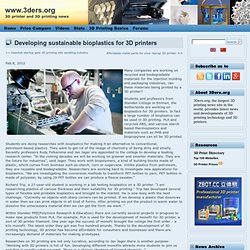
Students and professors from Stenden College in Emmen, the Netherlands are working on bioplastics for 3D printers. In fact a large number of bioplastics can be used in 3D printing. PLA and recycled ABS, and various starch based thermoplastics and materials such as PHB and biopropylene can all be 3D printed. Students are doing researches with bioplastics for making it an alternative to conventional, petroleum-based plastics. Richard Trip, a 27-year-old student is working in a lab testing bioplastics on a 3D printer. Within Stenden PRE(Polymore Research & Education) there are currently several projects in progress to make new products from PLA. Researches on 3D printing are not only lucrative, according to Jan Jager there is another purpose: "Working with 3D printers is full of fun.
Photo: © HERMAN ENGBERS. Blog on 3D Printing News & Innovation. GmbH - Arboblend. ARBOBLEND© granules are 100% biodegradable and show comparable material properties as classic plastics with high impact strength(e.g.
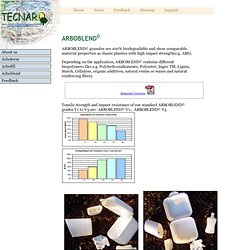
ABS). Depending on the application, ARBOBLEND© contains different biopolymers like e.g. Polyhydroxialkanoate, Polyester, Ingeo TM, Lignin, Starch, Cellulose, organic additives, natural resins or waxes and natural reinforcing fibers. Tensile strength and impact resistance of our standard ARBOBLEND© grades V1 to V5 are: ARBOBLEND© V1... ARBOBLEND© V5. The Chemical Institute of Canada. Plastics get a bad rap.
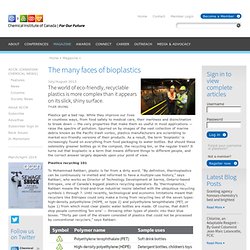
While they improve our lives in countless ways, from food safety to medical care, their inertness and disinclination to break down — the very properties that make them so useful in most applications — raise the spectre of pollution. Spurred on by images of the vast collection of marine debris known as the Pacific trash vortex, plastics manufacturers are scrambling to market eco-friendly versions of their products. As a result, the term ‘bioplastic’ is increasingly found on everything from food packaging to water bottles. But should these ostensibly greener bottles go in the compost, the recycling bin, or the regular trash?
It turns out that bioplastic is a term that means different things to different people, and the correct answer largely depends upon your point of view. Q&A: Can I make waterproof bioplastic? Recently we have received a number of comments asking us how people can make their own home-made bioplastics that are waterproof (or at least, water-resistant).
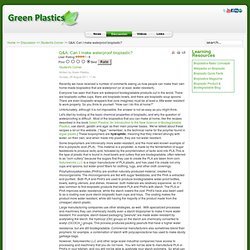
Everyone has seen that there are waterproof biodegradable products out in the world. There are bioplastic coffee cups, there are bioplastic bowls, and there are bioplastic soup spoons. There are even bioplastic wrappers that (one imagines) must be at least a little water resistant to work properly. So you think to yourself: "How can I do this at home? " Unfortunately, although it is not impossible, the answer is not as easy as you might think. Let's start by looking at the basic chemical properties of bioplastic, and why the question of waterproofing is difficult. Plastics vs. Bioplastics with manufacturers in Carbon Constrained World. Bioplastic from banana peels. Bioplastic Recipe 1. Making BioPlastics, Environmentally Friendly Plastics. Make your own bioplastic. Making a plastic from potato starch. In this activity students make a plastic from potato starch and investigate the effect that adding a ‘plasticiser’ has on the properties of the polymer that they make.

Students can begin either with potatoes or with commercially bought potato starch. The practical is straightforward, the main hazard being the mixture boiling dry. Extracting the starch takes about 15–20 mins and making the plastic film about 20 mins. A large pestle and mortar is needed to extract enough starch to make sufficient plastic to cover a petri dish.
If these are not available, students can use a smaller one and top up the starch they extract with commercially available potato starch. Each working group requires: Dilute hydrochloric acid, 0.1 M, about 10 cm3 Dilute sodium hydroxide, 0.1 M (IRRITANT), about 10 cm3 Potatoes, 100 g Distilled water, about 500 cm3 Access to: Potato starch - either extracted in the first part or 2.5 g bought potato starch Food colouring. Recycling polylactic acid. Thermoformable bio-plastic developed. A mock-up of a bio-plastics façade has been created that is made of 90% bio-plastics.
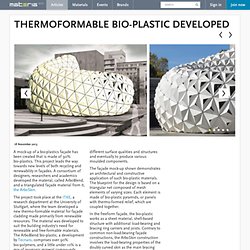
This project leads the way towards new levels of both recycling and renewability in façades. A consortium of designers, researchers and academics developed the material, called ArboBlend, and a triangulated façade material from it, the ArboSkin. The project took place at the ITKE, a research department at the University of Stuttgart, where the team developed a new thermo-formable material for façade cladding made primarily from renewable resources. The material was developed to suit the building industry’s need for renewable and free-formable materials. Bioplastic Experiment. Experiment home Objective The objective of the “Bioplastics Experiment” is to show the students the advantages and disadvantages of running a fractional factorial.

The students run a 2^k-1 fractional factorial to determine which levels of bioplastic ingredients / cooking method produce the best quality bioplastic. The students break up into four groups.